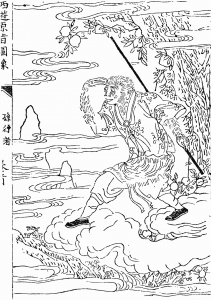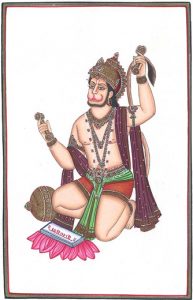20 The Monkey-King
Journey to America
Phuc Nguyen
Key terms
- Sun Wukung
- Journey to the West
- Xiyou ji
A Brief Introduction
“I need no introduction” [Proceeds to introduce himself] – Monkey King [1]
Sun Wu Kong, also known as The Monkey King is a character that most people know of from the 16th century Chinese novel by the name of Journey To The West.[2]
Throughout the novel, the Monkey is one of the monk Tang Sanzang’s guardians and followers on his journey to India. As the Monkey King, Wukong possess extraordinary power: immense strength, ability to travel using clouds, immortality, shape shifting abilities and possession of a giant staff that he can expand and shrinks at his command. Essentially, the 16th century Superman.[3]

Monkey King- The Origin
Though most people know the Monkey King from the novel Journey To The West, not many realize that the novel isn’t where Sun Wukong originates from, or at least Journey To The West itself wasn’t the first story where magical monkeys that live in the mountains were mentioned. Much like how the monk from Journey To The West, Tang Sanzang was based on the real monk Xuanzang from the Tang dynasty in the 7th century, with his journey to India being the inspiration to the novel Journey to The West; the Monkey King could potentially be based on another monkey from a different story that was created before the publication of Journey To The West.
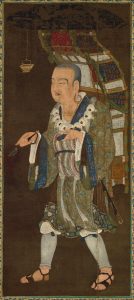
Meir Shahar believes that Sun Wukong is based on the legend of Huili.[4]
The Huili’s legend takes place in the year 330 (4th century) about the Buddhist master Huili who:
- Has a magical monkey as a disciple.
- The monkey lived in the mountain same as Wukong.
- Submits to the monk Huili just like Wukong submitting to Sanzang.
- Both characters travel between China and India together.
- Both reach the mountain Sakyamuni (Buddha’s abode)
- Monkeys from the Lingyin Monastery bare the name “Sun” similar to Sun Wukong.[5]
Though Huili’s legend takes place in the 4th century, poems and songs about the saga wasn’t written until the Tang period, taking place between the year 618-907. There are minor differences that distinguish Huili’s Legend from Journey To The West. For instance, Huili and his monkey disciple travels eastward rather than westward from China to India.[6]
Does this make Huili’s Legend the origin of Wukong? Not really, since there is no concrete evidence that links them together. What this information does tell us, is that Wukong isn’t the first magical monkeys ever recorded in Chinese History and that the Monkey King is heavily influenced by previous work of literature way before the 16th century.
Sun Wukong= Hanuman
Influences on the Monkey may come from but are not limited to China alone. This is because around the 11th century in India, Valmiki, author of the epic Ramayana made a character that similar to the Monkey King called Hanuman. But is the Monkey King influenced by Hanuman or is it the other way around?[7]
Regardless of these similarities, historical researchers can’t reach a common ground on whether or not Journey To The West was heavily influenced by Valmiki’s Ramayana.[8] So unless there is clear evidence that shows the author of JTTW, Wu Cheng’en, admitting that his novel was directly influenced by Valmiki’s Ramayana, there is no definitive comparison that can be made between the two characters. Potentially, the similarities that these two characters possess might come from oral literature and instead of a written story, it could be an opera or storytelling session that constantly modified every time it is performed.[9]
Journey to America
This sections aims to list a number of American media adaptations in comparison to the original novel, in order to figure out what about the character has changed.
Despite coming from an old novel, Wukong remains an iconic character to this day (specifically in Asia). The character is constantly being referenced in different form of media. On top of character like Son Goku from Dragon Ball[10] and the monster Infernape from Pokemon,[11] a brand new adaptation of the character called Monkey King- The Volcano is coming out this 2019. The King remains a well-known character specifically China as a cultural icon, due to his transformation in the story from an immoral trickster into a heroic Buddhist disciple by the end of the story. His faithfulness to Sanzang and their journey helps promotes the religion Buddhism in China.[12]
Due to the character popularity, Wukong was bound to be introduced to the American culture sooner or later. So how is The Monkey King portrayed American culture and how does it differ from the Chinese Novel?
- American Literature: The novel Tripmaster Monkey written in 1989 is one of the first examples of the Monkey King being presented to American readers. Fusing two great Chinese literature into a theatre play, where in the novel the main character Wittman herself is playing both the character Guan Yu (from Romance ofThe Three Kingdoms) and Sun Wukong at the same time.[13]
- TV adaptation: The Lost Empire is one of the first TV adaptations that introduce the Monkey King to the American’s big screen in 2001. The story involves an American businessman Nicholas Orton who was sent back to the past to save the world.[14]
- Movie Adaptation: The Forbidden Kingdom made in 2006, similar to The Lost Empire, is a movie about an American man who was sent back to the past in order to save the world. The main character name Tripitaka. In the film, Tripitaka acts as an embodiment of the monk Sanzang as he carries out the monk journey in the novel.[15]
- New TV Adaptation: Last but not least, the most recent Netflix adaptation of the Monkey King in 2018, New Legends of Monkey presents the most simplistic version of Journey to the West to America yet. The female Sanzang travels with her companions Monkey, Sandy and Pigsy on a journey to save the world from demons.[16]
Based on these adaptations, what similarities can you point out from the pictures below?
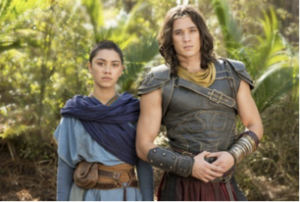
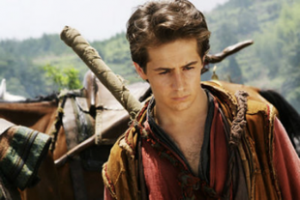
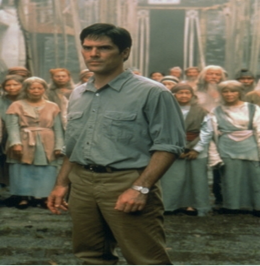
Detailed Answer: Apart from the novel adaptation in 1989, all the character above are white men who, regardless of whose roles they play in the adaptation are always depicted as “the white savior”. These changes makes the Monkey King seems inferior to the “main character”. Though it is true that the Monk Sanzang has full control over his disciple the Monkey King, it is a different matter for these adaptations since they are modernized. In The Lost Empire, the character Orton is a powerful representation of Tang Sanzang who is independent from Wukong. Besting the Monkey King in both brain and brawn, the story undermines the Monkey King’s power and role as a guardian within the story. The same pattern of storytelling is seen in The Forbidden Kingdom, where the character Tripitaka travels to save the imprisoned Monkey King. Aside from making Sanzang, the support character into the main character, some adaptation would do the opposite by making Sun Wukong himself weaker. Much like the new Netflix Adaptation, New Legends of Monkey, the Monkey King himself has lost all of his powers along with his staff, retaining only his martial arts skills. This ultimately makes the character Monkey King more “human” than godlike.
Simply put, through his journey to America. The Monkey King’s Americanization has made him weaker as Hollywood tries to reshape the character entirely. However, whether or not fans like these changes is a whole different matter.
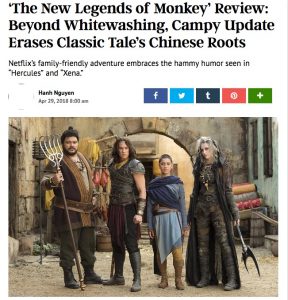
Bibliography
Dota 2 (version 7.21). Windows/Mac/Linux. Washington: Valve Corporations, 2013.
Dragon Ball. Directed by Akira Toriyama. Nagoya, Japan: Bird Studio, 1984, film.
Mair, Victor. 1989. “”Suen Wu-Kung= Hanumat? The Progress Of A Scholarly Debate”. In Zhongyang Yanjiuyuan Di Er Jie Guoji Hanxue Huiyi Lunwenji (Proceedings Of The Second International Conference On Sinology). Taipei: Academia Sinica, 1989, 659-752.
Pearson, J. Stephen. “The Monkey King In The American Canon: Patricia Chao And Gerald Vizenor’s Use Of An Iconic Chinese Character”. Comparative Literature Studies 43: 3 (2006), 355-374. doi:10.1353/cls.2007.0007.
Pokemon. Created by Tajiri Satoshi. Tokyo, Japan: Nintendo, 1996, DVD.
Shahar, Meir. “The Lingyin Si Monkey Disciples And The Origins Of Sun Wukong”. Harvard Journal Of Asiatic Studies 52: 1, (1992). doi:10.2307/2719331.
Taken. Directed by Pierre Morel. Hollywood: 20th Century Fox, 2012, film.
The Forbidden Kingdom. Directed by Rob Minkoff, Hollywood: Lionsgate, 2008, film.
The New Legends Of Monkey. Directed by Gerard Johnstone. Australia: Netflix, 2018, DVD.
The Lost Empire. Directed by Peter MacDonald. America: NBC, 2001, film.
Wu Cheng’en. Journey To The West. 1st ed. Ming Dynasty China, 1592.
- Video game Dota 2 (version 7.21). Windows/Mac/Linux. Washington: Valve Corporations, 2013. ↵
- Wu Cheng'en. Journey To The West. Ming Dynasty China, 1592. ↵
- Meme source photo: Morel, Pierre. 2012. Taken. Film. Hollywood: 20th Century Fox, Monkey King added with Photoshop by Phuc Nguyen. ↵
- Meir Shahar, "The Lingyin Si Monkey Disciples And The Origins Of Sun Wukong", Harvard Journal Of Asiatic Studies 52 (1), 194. ↵
- Ibid., 202-03 ↵
- Ibid., 223 ↵
- Victor Mair, "Suen Wu-Kung= Hanumat? The Progress Of A Scholarly Debate". In Zhongyang Yanjiuyuan Di Er Jie Guoji Hanxue Huiyi Lunwenji (Proceedings Of The Second International Conference On Sinology) (Taipei: Academia Sinica: 1989), 660. ↵
- Mair, 1989. ↵
- Ibid., 729. ↵
- Toriyama, Akira. Dragon Ball. Film. Nagoya, Japan: Bird Studio, 1984. ↵
- Tajiri, Satoshi. Pokemon. DVD. Tokyo, Japan: Nintendo, 1996. ↵
- J. Stephen Pearson, 357. ↵
- Pearson, 359. ↵
- Peter MacDonald, The Lost Empire, Film. America: NBC, 2001. ↵
- Rob Minkoff, The Forbidden Kingdom. (Film, Hollywood: Lionsgate, 2008). ↵
- Gerard Johnstone, The New Legends Of Monkey. (DVD, Australia: Netflix, 2018). ↵
A character with godlike powers from the Ramayana, a series written by the Indian scholar Valmiki.
A great Chinese Novel that is part historical, part legend, and part mythical – romanticism and dramatizes the lives of feudal lords and their retainers, who tried to replace the dwindling Han dynasty or restore it.
(Also known in English as “Three Baskets”) is a traditional term for the Buddhist scriptures containing Buddhist teaching. In modern adaptations, Tripitaka also refers to Tang Sanzang.
